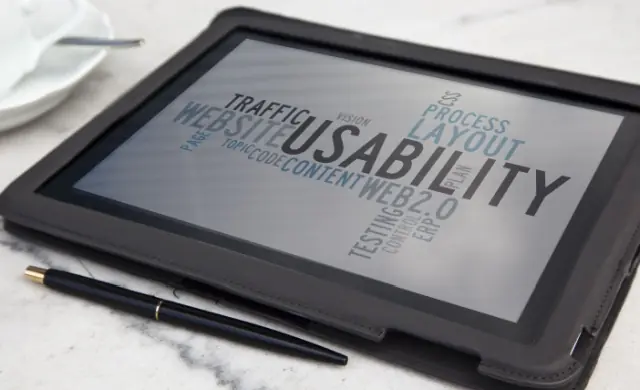Usability testing is a key step in making products that people enjoy using. Whether you’re working on a website, app, or software, it ensures your design is easy to use and simple to navigate. In this article, we’ll look at how website usability testing and usability testing services can help improve your web development process, boost user experience, and ensure your product’s functionality. It’s important to know how real users interact with your product to make sure it not only looks good but also works smoothly.
In the next sections, we’ll cover the basics of usability testing. We’ll explain what usability testing is, explore different types, and help you choose the best option for your business. We’ll also discuss the commercial benefits of usability testing. Whether you’re aiming for better user satisfaction or improved business results, this article will give you valuable tips to help you reach those goals.

What is Usability Testing?
Usability testing is a method used to evaluate how easy and user-friendly a product is by observing real users as they interact with it. This process helps identify issues with design, navigation, or functionality that could impact user experience. It ensures the product meets user expectations, is intuitive, and is free from usability flaws. Usability testing services often focus on testing website or app designs, gathering insights on user behavior, and improving the overall user experience. It’s an essential part of web development, allowing developers and designers to catch potential problems early, ultimately making the product more functional and enjoyable for users.
Through user testing, companies can improve the overall user experience. It helps ensure that the product functions smoothly and delivers a satisfying user journey, increasing customer satisfaction.

Commercial Benefits of Usability Testing
Usability testing offers many commercial advantages for businesses aiming to create user-friendly products. By focusing on real user interactions, this process helps improve design, functionality, and product success. Below are some of the key benefits usability testing brings to businesses:
1. Improved User Experience
Usability testing identifies pain points and issues early in the design process. This allows businesses to enhance the user experience by fixing problems before the product is released, leading to higher user satisfaction.
2. Cost Savings
Catching and addressing usability issues early reduces the need for expensive post-launch redesigns. It also minimizes the cost of fixing bugs or making improvements after the product is in the market.
3. Increased Conversion Rates
By improving ease of use, businesses can optimize their websites and apps for better conversions. Usability testing helps streamline the user journey, making it easier for customers to complete tasks like making purchases.
4. Reduced Time to Market
With several rounds of usability testing, businesses can identify issues faster and implement changes quickly. This helps to shorten development cycles and get products to market faster.
5. Data-Driven Decisions
Usability testing focuses on collecting insights from real users. Businesses can make informed decisions based on feedback, metrics, and analytics rather than assumptions, resulting in more user-centered products.
6. Higher Customer Retention
A seamless, intuitive user experience leads to better customer retention. When users find a product easy to use, they are more likely to return and stay loyal to the brand.
7. Competitive Advantage
Conducting usability testing provides businesses with a deeper understanding of their target audience than their competitors. This gives them a competitive edge by creating products that better meet user needs.
8. Improved Brand Reputation
By delivering well-designed, user-friendly products, businesses can improve their reputation. Positive user experiences lead to higher satisfaction, resulting in better word-of-mouth marketing and brand perception.
By leveraging usability testing services, businesses can optimize their UI UX design and improve their user experience, creating successful, user-centered products.

Different Types of Usability Testing
Usability testing plays a critical role in improving the overall experience of digital products. There are various types of usability testing, each designed to offer insights at different stages of product development. Below, we explore key types of usability testing, their benefits, and when to use them.
1. Moderated Testing
Moderated usability testing involves a facilitator guiding users through tasks while observing their actions and responses in real-time. The moderator can interact with users, ask follow-up questions, and clarify instructions as needed.
Benefits
- Provides real-time feedback and the ability to probe for deeper insights.
- Observes non-verbal cues, such as body language and facial expressions.
- Allows for immediate adjustments during the test.
When to use it
Use this type of testing in the early stages of product development, especially for complex processes or prototypes that require in-depth feedback.
2. Unmoderated Testing
Unmoderated usability testing allows users to complete tasks independently without a facilitator. They perform the test on their own time and submit feedback through recorded sessions or surveys.
Benefits
- More cost-effective and faster to conduct.
- Reduces the potential for moderator bias.
- Provides flexibility for participants to complete tasks at their convenience.
When to use it
Best suited for later stages of development when you need to test on a larger scale or when you’re looking for quick insights into general usability.
3. Remote Testing
Remote usability testing can be either moderated or unmoderated and involves users completing tasks from their own environments. This method allows for testing with participants from different geographic locations.
Benefits
- Increases access to a wider range of participants.
- Reduces logistical challenges related to in-person testing.
- Provides more natural insights, as users are in their familiar environments.
When to use it
Use this when you need a diverse user base or when testing under real-world conditions is essential.
4. A/B Testing
A/B testing compares two versions of a design to determine which one performs better in terms of user engagement and satisfaction. It’s particularly useful for testing changes in design elements like buttons or page layouts.
Benefits
- Provides clear data on which version users prefer.
- Helps optimize conversion rates and user satisfaction.
- Ideal for making data-driven decisions based on user interaction.
When to use it
Best used during the refinement stage of a design, after the product is live, to continually improve elements based on user feedback.
5. Hallway Testing
Hallway testing involves selecting random, non-expert users to test a product. This method is simple, low-cost, and helps identify major usability issues quickly.
Benefits
- Provides fresh perspectives from unbiased users.
- Helps catch fundamental usability issues early on.
- Quick and easy to set up with minimal cost.
When to use it
Use this method during the initial stages of development to get early feedback on basic functionality.
6. Guerilla Testing
Guerilla testing is a cost-effective method where testers approach users in public spaces to test a product. It’s informal and provides immediate feedback.
Benefits
- Inexpensive and easy to conduct.
- Offers quick insights and feedback.
- Ideal for early-stage testing to catch glaring issues.
When to use it
Use this during the concept or prototype phase when you need immediate feedback but don’t require a formal testing setup.
7. Eye-Tracking Usability Testing
Eye-tracking tests involve using technology to track where users look on a screen, helping identify what catches their attention and what they ignore.
Benefits
- Highlights which areas of the interface draw the most attention.
- Helps optimize page layouts by understanding user focus.
- Identifies usability issues related to visual engagement.
When to use it
This method is useful when you need to understand visual hierarchy or improve content placement on interfaces.
8. Quantitative Testing
Quantitative testing collects numerical data, such as task success rates, time spent on tasks, or error rates. This testing helps analyze patterns and user behavior across large groups to make data-driven decisions.
Benefits
- Provides measurable, statistically significant data.
- Enables comparison between different designs or user groups.
- Scalable, allowing for testing with large sample sizes.
When to use it
Best used when validating design decisions and tracking performance metrics, especially for large-scale projects.
9. Qualitative Testing
Qualitative testing focuses on collecting in-depth insights into user behavior, thoughts, and motivations through interviews, observations, and think-aloud sessions. It helps explore why users act a certain way.
Benefits
- Uncovers deep insights into user needs and emotions.
- Provides context to numerical data, enhancing understanding.
- Identifies underlying usability issues.
When to use it
Use qualitative testing when exploring new design concepts or when you need detailed insights into user interactions and preferences.
10. Card-Sorting
Card-sorting involves asking users to organize topics into groups that make sense to them. It’s used to structure websites, apps, or software based on how users expect information to be arranged.
Benefits
- Improves information architecture by reflecting user logic.
- Reduces confusion by aligning content with user expectations.
- Offers insights into how users categorize and prioritize information.
When to use it
Best used during the planning or redesign phase to structure content or navigation menus.
11. Accessibility Testing
Accessibility testing ensures that a product is usable by people with disabilities. It focuses on evaluating features like screen readers, color contrast, and keyboard navigation.
Benefits
- Ensures compliance with accessibility standards (e.g., WCAG).
- Increases product usability for a wider audience.
- Enhances user experience for people with varying abilities.
When to use it
Conduct accessibility testing throughout development, especially before launch, to ensure inclusivity and compliance with legal requirements.
12. Concept Testing
Concept testing evaluates new product ideas or features by presenting them to users for feedback before development begins. It helps gauge user interest, desirability, and potential usability of the concept.
Benefits
- Reduces the risk of investing in unviable ideas.
- Provides early-stage feedback to guide product development.
- Helps prioritize features based on user demand.
When to use it
Use concept testing during the ideation phase to validate new ideas before committing resources to development.
13. Explorative Testing
Explorative usability testing involves users interacting with a product prototype to explore how it works. This type of testing helps gather feedback on how users approach tasks without specific instructions.
Benefits
- Encourages users to discover issues naturally.
- Provides insights into user expectations and mental models.
- Identifies pain points early in the design process.
When to use it
Use explorative testing in the early stages of development to uncover unanticipated usability challenges.
14. First-Click Testing
First-click testing measures where users click first when trying to complete a task on an interface. It evaluates how intuitive the design is for guiding users to the right action.
Benefits
- Identifies navigation issues early on.
- Improves user satisfaction by optimizing task flows.
- Enhances user experience by streamlining important actions.
When to use it
Use this testing method to ensure that key tasks, like completing a form or making a purchase, are easy to find and complete.
15. Session-Recording
Session-recording captures user interactions with a product, including clicks, scrolling, and mouse movements. It provides insights into how users engage with a website or app in real time.
Benefits
- Highlights usability issues without user bias.
- Tracks user behavior patterns for future design improvements.
- Allows continuous testing and improvement.
When to use it
Use session recording to monitor live user interactions post-launch and identify areas for optimization based on actual user behavior.
By understanding the different types of usability testing and their benefits, businesses can choose the right methods at the right stages, ensuring a smoother and more user-friendly product.

Choosing the Right Usability Test for Your Business
When selecting a usability testing method, it’s essential to consider various factors to ensure you gather the right insights for your product. The choice of test type can impact both the quality and relevance of the data you collect. Here are 10 key factors to consider:
1. Project Stage
Early-stage projects benefit from explorative testing, while more developed products need summative tests to check usability.
2. Complexity of Tasks
For simple tasks, unmoderated testing works well, but for complex workflows, moderated testing provides richer insights.
3. Time Constraints
Unmoderated testing can be conducted quickly, while moderated tests need more time to plan and execute.
4. Budget
Moderated tests are more resource-intensive, whereas unmoderated tests are cost-effective for larger-scale testing.
5. Number of Participants
Consider the size of your testing group. Larger groups are easier to handle with unmoderated methods, while smaller, more detailed studies benefit from moderated testing.
6. Geographical Reach
If you need to test users in different locations, remote testing is ideal, as it eliminates geographical limitations.
7. User Familiarity
For products targeting novice users, guerrilla or hallway testing can provide quick, real-world feedback.
8. Type of Feedback Needed
If qualitative insights are a priority, moderated testing is better. For quantitative data, unmoderated methods or A/B testing work well.
9. Technological Limitations
If your product has specific technical requirements, such as hardware, in-lab testing might be necessary to ensure proper setup.
10. User Context
Testing users in their natural environments through remote or contextual inquiry provides more authentic insights than lab-based testing.
Aligning Usability Testing with Business Goals and User Needs
To make your usability testing effective, you need to align it with your business goals and user needs. First, figure out what your business wants to achieve. Are you aiming to boost user retention, improve conversion rates, or increase customer satisfaction? These goals will shape your usability testing process, making sure the data you collect helps you meet your business targets.
At the same time, it’s just as important to understand what your users need. Different users expect different things depending on the product or service you’re offering. A UX research agency can help you identify key user behaviors and preferences. This ensures your user experience testing is tailored to their needs. Whether you’re testing a responsive web design or a new feature, aligning your UI UX design with user needs will ensure your product meets both business and user expectations. This approach helps businesses achieve better results and create more successful products.

Enhancing Business Success with Usability Testing by ScreenRoot
Investing in usability testing is key for businesses that want to create easy-to-use products. By spotting usability issues early and refining the product with several rounds of testing, companies can boost customer satisfaction and improve product success. This not only enhances the user experience but also increases conversion rates, cuts development costs, and speeds up time to market. The UX metrics collected during testing help businesses make better decisions, ensuring products meet both user needs and business goals.
ScreenRoot, awarded UI UX Digital Agency of the Year 2024 at the Great Indian BFSI Awards, offers tailored usability testing services designed to fit your specific needs. Our team also specializes in UI UX design, UX research, enterprise application design, and more. Let us help you optimize your product’s usability and create a better user experience. To explore our work, visit our Work Page. For more details, WhatsApp us, call 1800 121 5955 (India), or email us at [email protected]. You can also reach us through our Contact Form for a prompt response.







